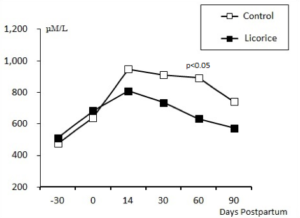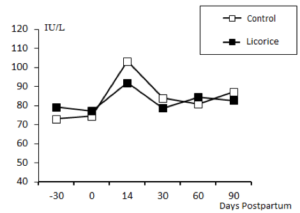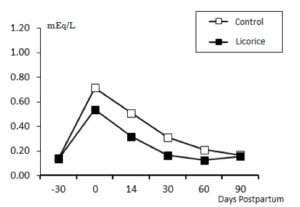Utilization of Medicinal Herbs to Maintain Liver Function
in Peripartum Dairy Cows
– The Effects of Feed Supplementation with Licorice –
Prof. Masateru Koiwa
Department of Veterinary Medicine, School of Veterinary Medicine,
Rakuno Gakuen University
Introduction
Modern genetic selection has resulted in dairy cows with higher milk yields. Post partum problems caused by reduced liver function such as ketosis and mastitis, metabolic diseases such as displacement of the abomasum and subclinical ketosis in particular are on the rise and investigations are underway to address these issues.
Subclinical ketosis is a condition preceding ketosis that is caused by insufficient energy supply postpartum and/or impaired liver function. Symptoms include ketonemia and ketonuria (or ketonlactia). It is known that 10 to 30 percent of dairy cows in early lactation exhibit subclinical ketosis leading to loss of milk yield, reduced reproductive performance, reduced immunity and occurrence of peripartum diseases.
Subclinical ketosis can be screened for or monitored by evaluation of ketone bodies (3-hydoroxybutyrate; BHBA) found in blood, urine or milk. While blood BHBA levels in healthy cows are below 560 µM/L, cows with subclinical ketosis will show levels higher than 800 µM/L. It has been reported that once blood BHBA levels rise above 1,400 µM/L, incidence of displacement of the abomasum increases by three-fold. Further, digestive system diseases and liver function disorders due to mycotoxin contamination in stored forage are also occasionally seen.
Here, we studied the effects of licorice, a medicinal herb known to improve liver function, on maintaining liver function in peripartum dairy cows when added to their diet.
1.What is licorice?
Licorice is the root of a legume plant native to East Asia. In human medicine, it is known as a medicinal herb containing glycyrrhetinic acid as a major component that has an effect to improve liver function. In livestock, its effects to improve reproductive problems and immune function when added to feed are being studied.
2.Supplementation of licorice to feed
15 pregnant cows reared at our school were used for this study. The 15 cows were allocated to two groups; 5 to the control group and 10 to the licorice group which received 200 g/head/day (contains 20 g of licorice) of licorice pellets added to their feed.
The licorice pellets were fed for a total of 120 days starting from 30 days prior to due date until 90 days postpartum. Blood samples were taken on six occasions; on day 30 prior to due date, the day of parturition, days 14, 30, 60 and 90 postpartum, and results were compared between the two groups.
3.Results
To evaluate liver function of cows, changes in blood 3-hydoroxybutyrate (BHBA) concentration, serum GOT activity and serum free fatty acid level (NEFA) were compared between the control and the licorice groups. Results are shown in Figures 1, 2 and 3.
(1) Blood BHBA concentration (Figure 1)
The BHBA concentration in the control group increased postpartum peaking on day 14 postpartum at 947+481 µM/L and then remained within the subclinical ketosis range of 800 µM/L or higher until 90 days postpartum.
Whilst, in the licorice group, the concentration increased until day 14 postpartum, similar to the control, but the level on day 14 postpartum was 809+378 µM/L and lower than that of the control. Levels in the licorice group then continued to stay lower than the control and did not reach levels that would be considered as subclinical ketosis.
(2) Serum GOT activity (Figure 2)
Serum GOT activity in the control group peaked at 103+19 IU/L on day 14 postpartum and then ranged between 81 – 87 IU/L after day 30 postpartum.
Similar to the control, serum GOT activity in the licorice group was elevated on day 14 postpartum, however, the level was 92+15 IU/L and lower than that of the control. Changes in serum GOT activity levels then on were similar to the control.
(3) Serum NEFA concentration (Figure 3)
Serum NEFA concentration in the control group peaked at 0.72+0.41 mEq/L on the day of parturition and then decreased gradually after day 14 postpartum.
Similar to the control, serum NEFA concentration in the licorice group peaked on the day of parturition at 0.54+0.40 mEq/L, however, this was lower than that of the control. Levels then on gradually decreased similar to the control.
Figure 1. Comparison of Blood BHBA Concentrations

Figure 2. Comparison of Serum GOT Levels

Figure 3. Comparison of Serum NEFA Concentrations

4.Conclusion
Licorice, which is known to improve liver function in human medicine, was added to the feed for 120 days, from 30 days prepartum to 90 days postpartum, with the aim to improve/maintain liver function in dairy cows and blood parameters to evaluate liver function were compared between the control and the supplemented groups.
As the result, reduced blood BHBA, serum GOT activity and serum NEFA levels were observed in the licorice supplemented group. Thus, it was confirmed that adding licorice to the feed avoided subclinical ketosis and maintained healthy liver function during the peripartum period in these dairy cows. This was assumed to be a result of the effect from the main component of licorice, glycyrrhetinic acid, leading to an improvement of liver function.
Based on the above results, it was confirmed that supplemental licorice in feed may be beneficial to mitigate subclinical ketosis and to maintain the liver function healthy. Currently, its effects on milk production and reproductive performance are also being investigated.
 Modern genetic selection has resulted in dairy cows with higher milk yields. Post partum problems caused by reduced liver function such as ketosis and mastitis, metabolic diseases such as displacement of the abomasum and subclinical ketosis in particular are on the rise and investigations are underway to address these issues.
Modern genetic selection has resulted in dairy cows with higher milk yields. Post partum problems caused by reduced liver function such as ketosis and mastitis, metabolic diseases such as displacement of the abomasum and subclinical ketosis in particular are on the rise and investigations are underway to address these issues.


 大分県竹田市久住町勉強会(Facebook)
大分県竹田市久住町勉強会(Facebook)

